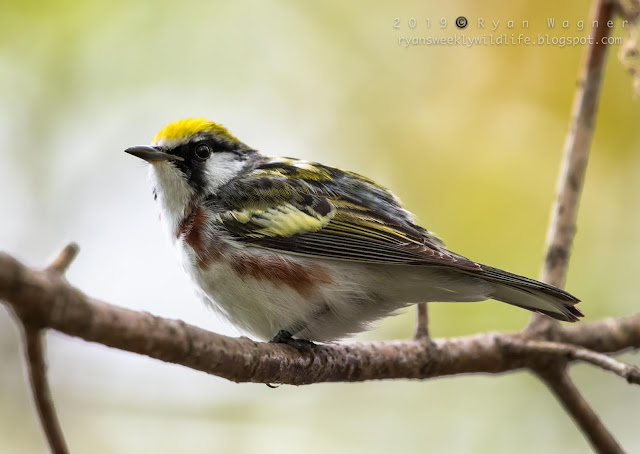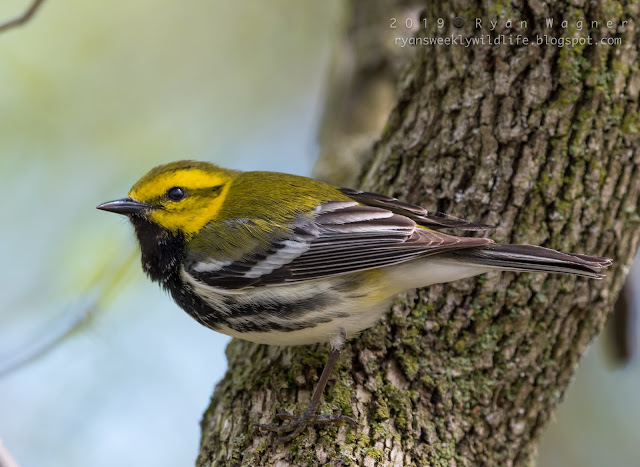 |
Black-throated Blue Warbler (Setophaga caerulescens)
|
 |
| Radar image of migrating birds. |
 |
Magnolia Warbler (Setophaga magnolia)
|
Magee Marsh is Disney World for Wildlife Watchers. It’s famous. It’s crowded. But, depending on who you ask, it just might be worth the hype. I have visited the Magee boardwalk many times over the past few years, but never during the famed “Biggest Week in American Birding.” I’ve always been a little too early or a little too late for the mass arrival of over twenty warbler species. Each trip still brings loads of birds, unusual rarities, and a lifer or two, but I’ve always been curious about the Big Week. On May 10th of this year, I headed up to Birder Mecca, braving the crowds for the promise of rare migrants.
 |
Cape May Warbler (Setophaga tigrina)
|
 |
Northern Parula (Setophaga americana)
|
 |
Chestnut-sided Warbler (Setophaga pensylvanica)
|
 |
Bay-breasted Warbler (Setophaga castanea)
|
 |
| Tennessee Warbler (Leiothlypis peregrina) |
On sunny mid-morning days during the Big Week, birds might be outnumbered ten to one by birders, but don't let that fool you about the shear abundance and variety that can be found here. Like fish that occupy different water columns in an aquarium, there is a bird for every level of the swampy woodland.
 |
Palm Warbler (Setophaga palmarum)
|
Keep a close eye on the ground for little, brown birds with bobbing tails. The Northern Waterthrush can be expected anywhere the ground is wet. Despite its name and drab colors, this is in fact a warbler. Another thrush-like ground-dweller, the Ovenbird, is a common species throughout much of the state. Moving up into the understory shrubbery, you can expect to see foraging Black-throated Blue Warblers, Palm Warblers, and the occasional Wilson's Warbler. Be sure to take a second look at any peculiarly patterned nuthatches—they might turn out to be Black-and-White Warblers creeping up the tree bark.
 |
| Northern Parula (Setophaga americana) |
At the mid-level range, a good day will bring Magnolia warblers, Cape-may warblers, Bay-breasted warblers, Black-throated Green Warblers, American Redstarts, and Prothonotary Warblers. Two of the most common warbler species often dominate this section of the forest: Yellow warblers and Yellow-rumped Warblers. The dense, shaded vegetation may harbor Hooded Warblers, or the rare Canada Warbler.
 |
Black-throated Green Warbler (Setophaga virens)
|
You might have to strain your neck peering into the canopy to spot these warblers, but with any luck it'll be well worth it. Foraging in the very tops of the trees are Northern Parulas, Tennessee Warblers, Nashville Warblers, and maybe even Cerulean Warblers. My favorite of the bunch, the Blackburnian Warbler can be seen picking insects off the ends of branches right above the boardwalk.
Extreme rarities occasionally turn up at Magee during the Big Week. Saying the words Connecticut warbler, Mourning Warbler, or the endangered Kirtland’s Warbler on the Magee boardwalk is akin shouting fire in a crowded theater.
Extreme rarities occasionally turn up at Magee during the Big Week. Saying the words Connecticut warbler, Mourning Warbler, or the endangered Kirtland’s Warbler on the Magee boardwalk is akin shouting fire in a crowded theater.
 |
Blackburnian Warbler (Setophaga fusca)
|
If you are just getting in to birding, then the shear number of similar-looking warbler species might be a bit daunting (it certainly was for me). In that case, I’d recommend a spring trip to Magee even more. There is no better way to learn your birds than getting out in the woods with a pair of binoculars.
And, if all else fails, just ask the birder next to you what he or she is looking at.
 |
Yellow Warbler (Setophaga petechia)
|
More soon!
Keep living the field life
Ryan





